GEISHAS AND THE MODERN WORLD
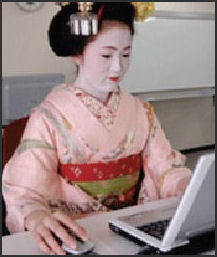
maiko working on her blog Some geishas work as nightclub singers in their free time. Others run bars to supplement their geisha income. To attract customers some geisha houses have replaced samisen music with karaoke machines. The customers are not just men any more: many are women, families and foreigners eager to sample the geisha experience. To keep up to date, maikos are studying English and running promotional blogs. In Kyoto there is a special English textbook designed specifically for maikos.
There is a shortage of geisha samisen players. One 60-year-old former geisha told Newsweek, "Most of today's geisha don't have gei, or artistic skills."
Many geishas are free agents. Once they have put in enough time at the geisha houses to pay the house back for training and accommodation, the geishas are free to do what they please. Most get referrals through their geisha house but as a free agent they are allowed to turn down offers if they want.
These days men find hostess bars to be considerably cheaper than a geisha and find various types of sex services available to be more fulfilling. One geisha told the Daily Yomiuri, "Of course, some men still support us, but merely as sponsors. Today men would rather turn to ordinary women such as university students or office workers if they wanted to have an extramarital relationship."
Elements of mystery are being peeled away as geishas offer glimpses of their world. Still many girls want to be geisha. One ryotei owner told the Daily Yomiuri, “I often receive applications from would-be geisha. Their backgrounds vary, ranging from high school students and office workers to bar hostesses. The profession seems to have a certain popularity. But the hard work begins after they start their training as a geisha. They have to study a lot of things, including dance, instruments such as the tsuzuu and naguata.”
Websites and Resources
Good Websites and Sources: Immortal Geisha immortalgeisha.com ; Liza Dalby’s Geisha site lizadalby.com/LD/geisha ; Geisha, My Story thekeep.org/~kunoichi ; E-Book: Working Women of Japan (1915), containing a section on Geishas uoregon.edu/ec/e-asia/read/workingwomenofjapan ; A Maiko’s Account of Her Apprenticeship shinmonso.com/english/maiko ; Geisha Photos phototravels.net/japan ; Books: “Women of the Pleasure Quarters: The Secret History of the Geisha” by Tracy Dalby (2001, Broadway); “Geisha” by Jodi Cobb (1995, Alfred A. Knopf); “Geisha: The Secret History of a Vanishing World” by Lesley Downer (Headline, 2000); “Autobiography of a Geisha” by Sayo Matsuda (Columbia University Press, 2003); “A Geisha’s Journey, My Life as Kyoto Apprentice” By Naoyuki Ogino (Kodansha International , 2007), the story of a teenage schoolgirl who become a geisha.
Photos and Videos Good Photos at Japan-Photo Archive japan-photo.de ; Maiko Gallery art-e-zine.co.uk ; Photos of Gion Geisha khulsey.com ; Video of Maiko Putting on Make Up YouTube ; Geisha Dance Video robpongi.com ; Video of Maiko Going to Work YouTube ; Bookbrowse on the book “ Memoirs of a Geisha “ bookbrowse.com ; “ Memoirs of a Geisha film “ sonypictures.com/homevideo/memoirsofageisha
Gion is the main geisha district in Kyoto . Websites Japan Guide japan-guide.com. Gion Corner at Yasaka Kaikan Hall features a one-hour show with quick demonstrations of seven different traditional art forms: the tea ceremony, flower arranging, koto music, “gagaku” (ancient court music), “kyogen” (traditionally comic drama), bunraku puppet drama and geisha-style women dances. Shows in English are conducted twice daily at 8:00pm and 9:10pm March through November. Website: Gion Corner kyoto-gion-corner.info. Kyoto Gion Hatanaka offers a night of food, entertainment with drinking games, food and a chat with maiko with an English interpreter and a an informal photograph session. For more information call tel. (075)-541-5315 or check their website Kyoto Gion Hatanaka ; Geisha Transformation Centers: Kyoto Tourist Information Center can provide you with list and information on Geisha Transformation Centers. Call tel. 9742-(075)-371-5649. For a more authentic “tayu” look, complete makeovers are offered by the Japan Hairstyle Museum ( tel. 9742- 075-551-9071) for ¥50,000. Website: Bzzangent bzzagent.com
Links in this Website: GEISHAS Factsanddetails.com/Japan ; GEISHAS AND THE MODERN WORLD Factsanddetails.com/Japan ; CLASSICAL JAPANESE MUSIC Factsanddetails.com/Japan ; JAPANESE FOLK MUSIC AND ENKA Factsanddetails.com/Japan ; DANCE IN JAPAN Factsanddetails.com/Japan ; HOLLYWOOD FILMS ABOUT JAPAN Factsanddetails.com/Japan ; JAPANESE WOMEN Factsanddetails.com/Japan ; TAKARAZUKA, JAPANESE ALL-FEMALE THEATER Factsanddetails.com/Japan ;
Decline of Geishas
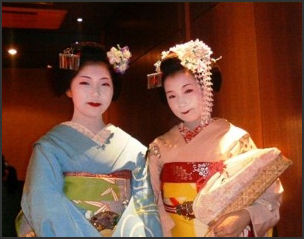
maikos There are less than a 1,000 geishas left in Japan today, down from around 80,000 during early 20th century. In Kyoto in 2000, there were about 197 geishas and 52 maiko. About half of them in Gion. The others are mostly in other geisha districts. There are currently about 100 maiko working in Kyoto.
The Asakusa district in Tokyo, once the home to 1,000 geisha, now has only 50. Geisha can also be found in the Tokyo districts of Shimbashi, Akasaka, Yoshicho, Mukojima and Kagurazaka. The number of ryotei in Tokyo has declined from 524 in 1977 to 82 in 2001. Mukojima was at its peak in the 1950s with 150 ryotei and 600 geisha now there are only 20 ryotei and 120 geisha. The number of geisha in Akasuka peaked at around 300 in 1956. Today there are only about 24 still working in the area.
Geisha work at the hot spring areas of Togurakamiyamada in Chikuma, Nagano Prefecture, Shibuyudanaka in Yamanouchi-machi in Nagano Prefecture and Ikaho in Shibukawa in Gunma Prefecture. Nagano Prefecture had 20 geisha associations 20 years ago but now only has three. Togurakamiyamada around Zenkoji temple in Nagano had 300 geishas in the 1960s and 70s but now has less than 100.
The number of geishas has declined because few men have the money to enjoy traditional geisha night outs; less women want to be geishas; and parents no longer need to sell their daughters into geishahood to feed their families. In addition few men can afford to be danna and few wives are willing to tolerate a husbands who spends a fortune on maintaining a geisha.
The geisha industry was hit hard by an announcement in the early 1990s by Japanese Prime Minister Morihiro Hosokawa announced he would not go to any restaurant that cost more than $500. It was also hurt by outrage over expensive entertainment provided to bureaucrats and politicians.
With few patrons to support them, geisha have to hustle for money and market themselves like everyone else. Ryotei with geisha in the Mukojima district of Tokyo host shows showing geisha performing their traditional performing skills, with some places providing English explanations for non-Japanese customers and tourists. In Kyoto, ordinary people can pay about $120 for a dinner that includes a brief visit by a pair of maiko.
Last Geisha In Kamaishi Survives Four Tsunamis
Reporting from tsunami-hit Kamaishi, Norimitsu Onishi wrote in New York Times, “The requests to see her perform had dwindled over the years. But when the earthquake struck at 2:46 p.m. on March 11, this city’s last geisha was, fittingly, at home getting ready to sing that night at Kamaishi’s 117-year-old ryotei, an exclusive restaurant featuring fine food and entertainment where she began working as a 14-year-old seven decades ago. She had already put on the white split-toe socks she would wear with her kimono and was preparing to put her hair up. Hired to entertain a party of four in honor of a colleague’s transfer from Kamaishi, she had picked just the right song, one meant to steel young samurai going to their first battle.”[Source: Norimitsu Onishi, New York Times, April 4, 2011]
“But a tsunami would engulf this city within 35 minutes and, as Kamaishi trembled from at least 15 big aftershocks during that short time, the geisha, Tsuyako Ito, 84, fought to survive. She had lived through three tsunamis before in Kamaishi, a place that the waves have destroyed with regularity over the centuries, and as a girl she had listened to her grandmother’s tales of the great 1896 tsunami.”
“My grandmother said that a tsunami is like a wide-open mouth that swallows everything in its path,” Ms. Ito told the New York Times, “So that victory comes to those who run away as fast as possible.” Her mother carried her on her back to safety at the time of Ms. Ito’s first tsunami in 1933. This time, after her legs gave out, an admirer carried Ms. Ito on his back to higher ground.” It was her fourth — and “most frightening” — tsunami.
The March 11 tsunami devastated Kamaishi, tearing apart it breakwater and eventually reaching inland all the way to Ito’s house. “After a wall in her house collapsed and she slowly moved to flee,” Onishi wrote. “Hiroyuki Maruki, 59, a sake store owner and the president of a group dedicated to preserving an old melody called “Kamaishi Seashore Song,” came by looking for her.” “She is the only one who knows how to sing that song,” Mr. Maruki said. As Mr. Maruki carried Ms. Ito up a hill, she recalled “feeling the soft warmth of his back.” Mr. Maruki said: “I thought she’d be light, but she was surprisingly heavy. I wondered at one point what was I going to do.”
“Afterwards, Ito said that her regret was that she had been unable to sing that night. “I’d practiced the night before, and after putting my thoughts together, I thought this song would be all right,” she told the New York Times, explaining that the song told the story of a young samurai on horseback going to his first, long-awaited battle. “It ended without my singing,” she said. “It’s such a nice song, too.” The tsunami waves swept away her shamisen, a three-stringed instrument, and kimono, the two tools essential to a geisha’s art. But Ms. Ito vowed to sing and dance again in Kamaishi.
Story of Last Geisha and Ryotei in Kamaishi
In her time Ito was a famous beauty who both danced and played the shamisen, while most geishas were skilled only at playing the shamisen, Setsuko Kanazawa, whose family owns Saiwairo, the ryotei where she performs, told the New York Times. The last ryotei in Kamaishi, Onishi wrote, Saiwairo was also its most exclusive. It was built in 1894 on the most elevated point of an area that would be dotted with bars, brothels and other ryoteis. While tsunamis washed away Saiwairo’s neighbors, they never reached its first floor. It was at Saiwairo that Ms. Ito began an apprenticeship at the age of 14. [Source: Norimitsu Onishi, New York Times, April 4, 2011]
“I loved to dance,” she said. “And I simply wanted to become a leading geisha in Kamaishi.” The truth, whispered for decades inside the family home, was darker, said Satoshi Ito, Ms. Ito’s nephew. Ms. Ito’s father ran a small-time construction business and, her nephew said, had ties with Japan’s gangsters, the yakuza. “He would repair roads here and there, using yakuza to control certain areas,” said Mr. Ito, 63, who lived with his aunt here but is now staying at an evacuation shelter. “Her father is supposed to have told her she was suited for that life,” he added. “But to put it harshly, I think that he did it to guarantee some debts.”
“After a marriage to a sushi restaurant owner, the birth of a daughter and a divorce, Ms. Ito went to Tokyo to study dance under a famous instructor,” Norimitsu Onishi wrote in New York Times, “Back in Kamaishi, Ms. Ito and a dozen other geishas were constantly on call at this city’s ryoteis, as Kamaishi’s economy began booming in the 1950s. At Saiwairo, steel industry executives occupied some rooms as owners of fishing vessels held parties in others.”
“But Kamaishi’s economy peaked a decade before Japan’s did, as the city’s two main industries began declining in the 1970s. Nippon Steel began moving its operations out of Kamaishi, eventually closing down its blast furnaces in 1989; fishing shrank as new rules on exclusive economic zones kept Kamaishi’s fishing vessels closer to Japan. By the time Japan’s economic bubble burst two decades ago, company executives could no longer hire geishas on their expense accounts.”
Saiwairo opened its doors to a larger public, first as a new site for weddings; in recent years, in a reflection of this city’s aging population, it has become a popular setting for memorial services. “We couldn’t survive on pride alone,” Ms. Kanazawa said. Still, sometimes the calls came for Ms. Ito, some from old customers, others from new customers reflecting the world’s new economic order. “About once a month,” Mr. Ito said of the frequency of his aunt’s performances. “Chinese industrialists, among others, now come here.”
Harassment of Geisha
Geiko and maiko in Gion have complained about being harassed by tourists who pester them for photographs and ogle at them as theywalk to work. One 18-year-old maiko told the Yomiuri Shimbun, people “approach me without saying a word and suddenly stand beside me to have photographs, so I get taken by surprise.” Other have said tourists have tugged hard at their sleeves, causing them to nearly fall on their “ okobo” (“platform shoes”).
To help the Gion maikos and geikos messages have been posted on Kyoto’s English-language Web Site asking foreign tourist not to bother them. Residents and owners of restaurants in Gion escort the women to work and intervene is they are bothered.
Memoirs of a Geisha
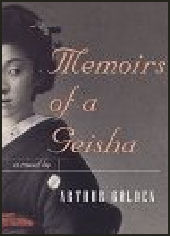
American version
of the book “Memoirs of a Geisha” is an entertaining and wonderfully written page-turner written by Arthur Golden. The book is about a young girl from a poor fishing village who sold into the geisha world and overcomes a geisha rival to become one of the top geishas in 1930s Japan. Golden has an eye for detail and the book does a fairly good of of conjuring up images of the geisha world in Japan of the 1920s and 30s.
”Memoirs of a Geisha” was a huge success. It was on the New York Times bestseller list for 58 weeks and sold more than 4 million copies in English and has been translated to 32 languages. It inspired a fascination in anything having to do with geishas. Models at fashion shows in Paris and Milan showed kimonos and obis after the book came out and tourists came to Japan looking for geishas.
Source of Memoirs of a Geisha
Much of material on geishas of “Memoirs of a Geisha” came from long interviews Golden conducted with Mineko Isawaki, a Kyoto geisha who was recruited at the age of 5 and worked in Gion for 23 years before retiring in 1980 to raise a family.
Isawaki was one of Kyoto's top geisha. She invited Golden to stay at her house for two weeks in 1992 and during that time described the intimate details of her profession. "I asked Mineko every question on my mind, a number of them about sex," Golden told Newsweek, "and she answered every one with candor. Even her husband was very nice. He bragged about the [sale of her virginity]. She'd set a record." Her virginity sold for about $850,000.
Isawaki later sued Golden for breach of contract and breaking an agreement to keep her identity secret. She asked for an "appropriate percentage" of the millions Golden earned from the book. A spokesmen for Golden's publisher said the allegations were "totally without merit." Most geisha donn’t t care about the book. They say much more unflattering and controversial books have been written by Japanese.
Memoirs of a Geisha Film

British version of the book “Memoirs of a Geisha” was made into an English-language film that was popular in the United States and Europe and drew large audiences in Japan, where it was called “Sayuri”, the name of the main character. However it was dismissed by many as Hollywood stereotyped nonsense.
The film critic Roger Ebert said: “I suspect the more you know about Japan and movies, the less you will enjoy “Memoirs of a Geisha”. Those with familiar with Japan the film found to be an oversimplified version of Golden’s novel, which in turn was an oversimplified depiction of the geisha world.
“Memoirs of a Geisha” was a real all Asian affair with Chinese actresses with Chinese actress Zhang Ziyi (From “Crouching Tiger, Hidden Dragon”) in the title role as Sakuri, Japanese star Ken Watanabe in the male lead, the Chinese actress Gong Li as Sakuri’s rival Hatsumomo, Malaysian-Chinese Michelle Yeoh as her teacher Mameha and Japan’s Kaori Momoi as mistress of the geisha house where Sayuri worked.
“Memoirs of Geisha” was directed by Rob Marshall, who did the hit musical “Chicago”. There were some rumors that Steven Spielberg was going to direct the film with Madonna in the leading role, supported by an all-Japanese cast lead by Martha Graham dancer Rika Okamoto. That obviously didn’t happen. Spielberg ended up producing the film but deferred on directing it after he became involved in other projects.
Some scenes were shot at temples and other locations in Kyoto, including Kiyomizu-dera temple and Fishimi-Inari Taisha shrine, famous for it hundred of vermillion torii gates, but most of it was shot at a replica of Kyoto’s geisha district — complete with streets, a river and period buildings — constructed on a ranch in Ventura County, California.
Controversy Over Memoirs of a Geisha Film
Many Japanese and other Asians were upset about the casting of non-Japanese in Japanese roles. Japanese feel their culture is unique and scoff at the idea of Chinese and other Asians playing Japanese while Chinese and other Asian still carry a lot of ill will towards Japan because of their history and also scoff at the idea of Chinese and Asians playing Japanese. The Chinese director Chen Kaige said, “Japanese culture, as well as Chinese culture has something very profound which can’t be easily expressed....For Hollywood, however does not matter, For them there is no difference between Japanese and Chinese.”
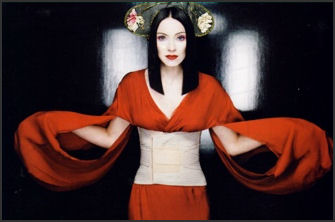
Madonna with a stylized geisha look The actors chosen for the lead parts were selected for their familiarity to American audiences and their ability to speak English. The calls for extras for the film called only for “light-skinned Asians.” One Korean-American actress who turned down a supporting role, told the Korean media,”Even if it is Hollywood I don’t wasn’t to start by playing a Japanese geishas. It’s a matter r pride.”
The Japanese media picked apart the film and said it was full of glaring mistakes. They particularly took offense to one scene that showed geishas being whipped, insisting that sort of thing didn’t take place in the geisha world. They also didn’t like the portrayal of a low-ranked sumo wrestler as a high-ranking yokozuna.
Critics of the critics pointed out that the Egyptian Omar Sharif played a Russian in Dr. Zhivago, Englishwoman Vivien Leigh played the southern American Scarlett Ohara in “Gone with the Wind”. Jude Law has played his share of American roles and Johnny Depp had played his share of British ones. In an op-ed piece in the Washington Post, Golden defended they film and his book, saying “It’s worth bearing in mind that “Hamlet” makes poor Danish history and that “Lawrence of Arabia” grossly over oversimplifies the culture of the Middle East.”
The makers of the film said they went through great lengths to make the film authentic. To prepare for the film Zhang and the others went through a six week “geisha boot camp” led by a team of experts. In addition to regular rehearsals they learned how to dance, move like a geishas and play the samisen. Zhang said at a news conference: “We had to learn how to walk, how to bow, how to kneel and how to give a nice tea ceremony, you know, all the small subtle gestures. We had so many things to learn. We tried to give our best efforts.” Yeoh described the seven room where their training took place as “seven rooms of torture.”
Those who want a realist look at the geisha world should check out “Hannari — Geisha Modern”, a documentary by female Japanese director Miyuki Sohara, who spent several years living among geishas and was given access to places and people usually denied by the media. The film includes footage of the ceremony in which a maiko is appointed a geisha.
Quasi and Fake Geishas

Is she real or fake? Many women that pass as geishas are not real geishas, but geishas wannabes known as “furisode-san”, who are hired to sit like mannequins in the lobbies of hotels and pose for photographs at weddings, tourist sights and New Year's parties. "Furisode-san" is the name of kimonos they wear which have sleeves that hang down to their ankles.
Furisode dress up like geishas, have white make up and provide entertain men at fancy restaurants like geishas but don’t have the training, fine clothes, hairdos or the studied elegance of geishas and cost less. They are associated with sakusa district of Tokyo
The majority of furisode-san are girls, in their late teens and early twenties, who attend a three-month crash course that teaches them to act like geishas and dance to taped music. They generally earn a salary of 250,000 yen a month.
Old-time geisha girls look down on newcomers who wear western clothes and panties. One entertainment reporter told Newsweek that the new breed of furisode-san "were interested in dances, have fantasized about wearing a kimono and will do this for only three or five years." He added the new generation of "karaoke people" don't want "to hear the traditional songs and old dances."
A version of Barbie dressed like a geisha is available.
Geisha Transformation Centers
In Kyoto, there around 50 "geisha transformation" services that charge customers $40 to $300 to dress them in a wig, kimono and make up so they look like geishas. They are then allowed to walk on streets for a hour or two, with a chaperon to make sure they don't do anything that harms the reputation of real geishas, who aren't fond of the fake geishas but have learned to tolerate them.
Among those who have undergone the transformation are teenagers, grandmothers, office ladies, factory workers, foreigners and even a few men. After the undergo the transformation they take photographs with one another and allow tourists to photograph them, and giggle when they are mistaken for real geishas. In the resort spa town of Atami, an easy commute from Tokyo, even true geishas have entered the fake geisha infrastructure. Treating customer to a make up session, kimono fitting and crash course on geisha manner for ¥12,800.
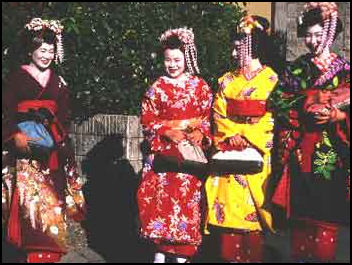
real or fake? Some of studios also turn men into samurais and shoguns and women into Heian princesses, characters from Japanese literature or a courtesans with 12-layer court kimono. The prices generally range from ¥7,000 to ¥35,000 depending in the type of costume and make-up desired. Visitors should expect to pay ¥10,000 to be dressed as a maiko and somewhat less to be a geisha. There often additional charges for walking around outside and having studio pictures taken.
The studios often require reservations at least several days in advance and are particularly busy on the weekends and around cherry blossom season in April and maple season in October and November. Kyoto Tourist Information Center can provide you with list and information on Geisha Transformation Centers. Call ☎ (075)-371-5649. For a more authentic “tayu” look, complete makeovers are offered by the Japan Hairstyle Museum (☎075-551-9071) for ¥50,000. Website: Geisha Makeover travel-kyoto.com
Make Up for a Fake Geisha
Luchina Fisher, a black woman who went through a geisha transformation, wrote in the New York Times, "After we got into undershorts and knickers and put on tabi, the white socks that button the sides and fit like mittens, the women set replicating the looks we had chosen from a photo album. Clad entirely in black, they worked quietly with the concentration of artists."
"One took what looked like a paint brush and covered my entire face with a heavy white paste, so that my moles and even my eyebrows were no longer visible. After a dousing of white powder, she took a smaller brush and painted strokes of pink in wide arcs around my eyes and cheekbones."
"Next, she places a piece of cardboard on the back of my neck and painted by neck and back with more white makeup. When she removed the cardboard three slivers of brown skin remained...the sanbon-ashu, or three-legged design, meant to show off the most erotic par of the body — the neck...The same woman gave me new eyebrows in a sweep...She lined my eyes in black and a dab of red in each corner to accentuate their almond shape. Lastly she painted a pair of scarlet lips on the center of my mouth."
Dressing Up as a Fake Geisha

Madonna with Geisha-style make up "On the other side of the room,” Fisher wrote. “I stood with my arms up while the dresser tied what looked like little pillows around my hips and bustline...The extra padding keeps the kimono from bunching at the waist. Next came a red under robe, visible at the collar and whenever I lifted the hem of my kimono."
"The kimono I had chosen was black with swirl of white, pink and gold fans at the bottom. It was given a brocaded gold obi, which had been wrapped around my waist and cleverly folded in back. When the dresser finished I noticed my hips and bottom had disappeared under cylindrical geisha shape."
"Finally, I was crowned with a wig, about five pounds of human hair swept away from face in an elaborate chignon and held in place with a large tortoise-shell combs." The wig was adjusted with soft pads underneath and kept it in place was a balancing act. "A flower and hair ornament were added to the front, and a folded fan was tucked in my obi."
Image Sources: Liza Dalby's geisha website except books (Amazon) and geisha with umbrella (Ray Kinnane)
Text Sources: New York Times, Washington Post, Los Angeles Times, Daily Yomiuri, Times of London, Japan National Tourist Organization (JNTO), National Geographic, The New Yorker, Time, Newsweek, Reuters, AP, Lonely Planet Guides, Compton’s Encyclopedia and various books and other publications.
Last updated July 2020
